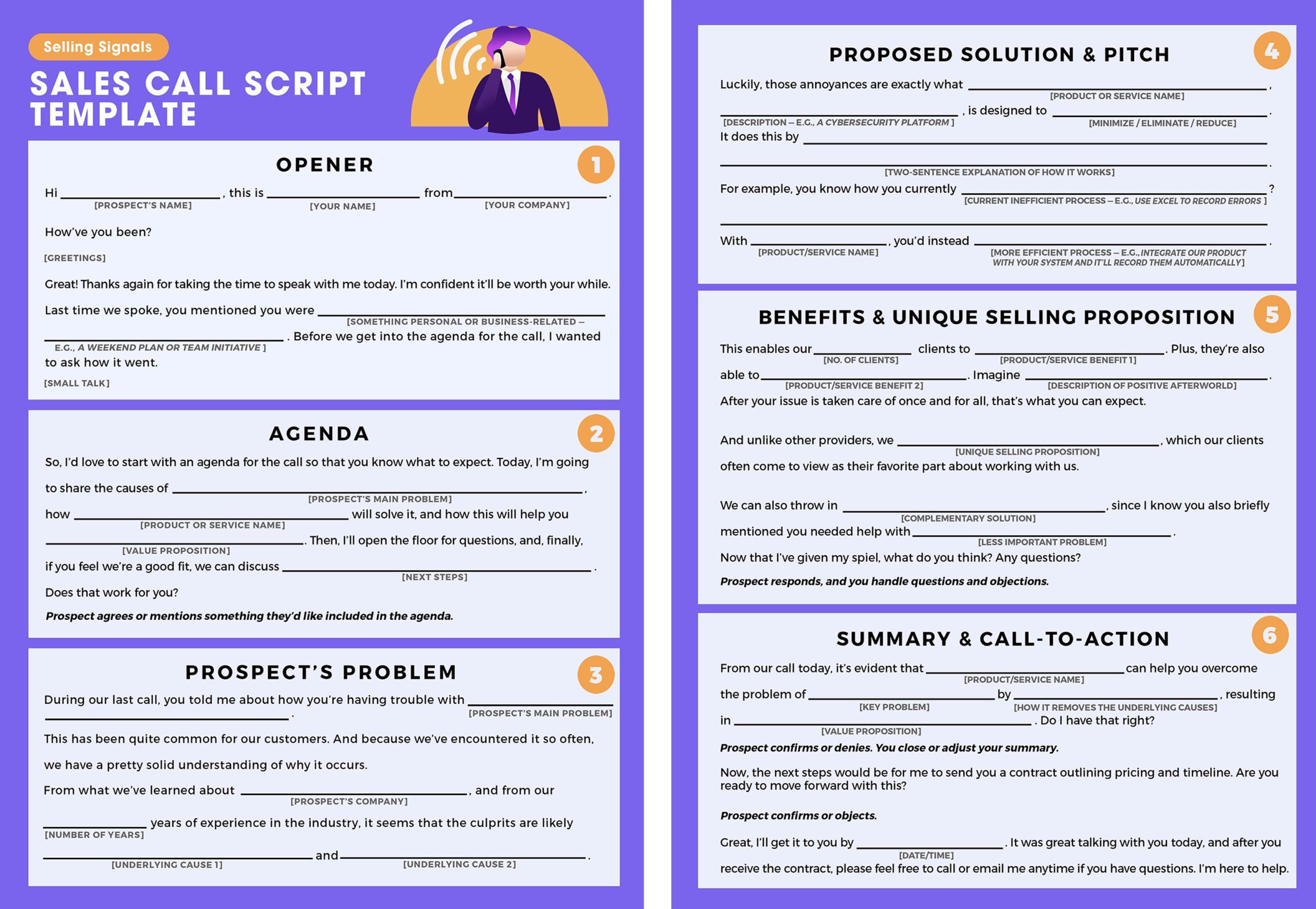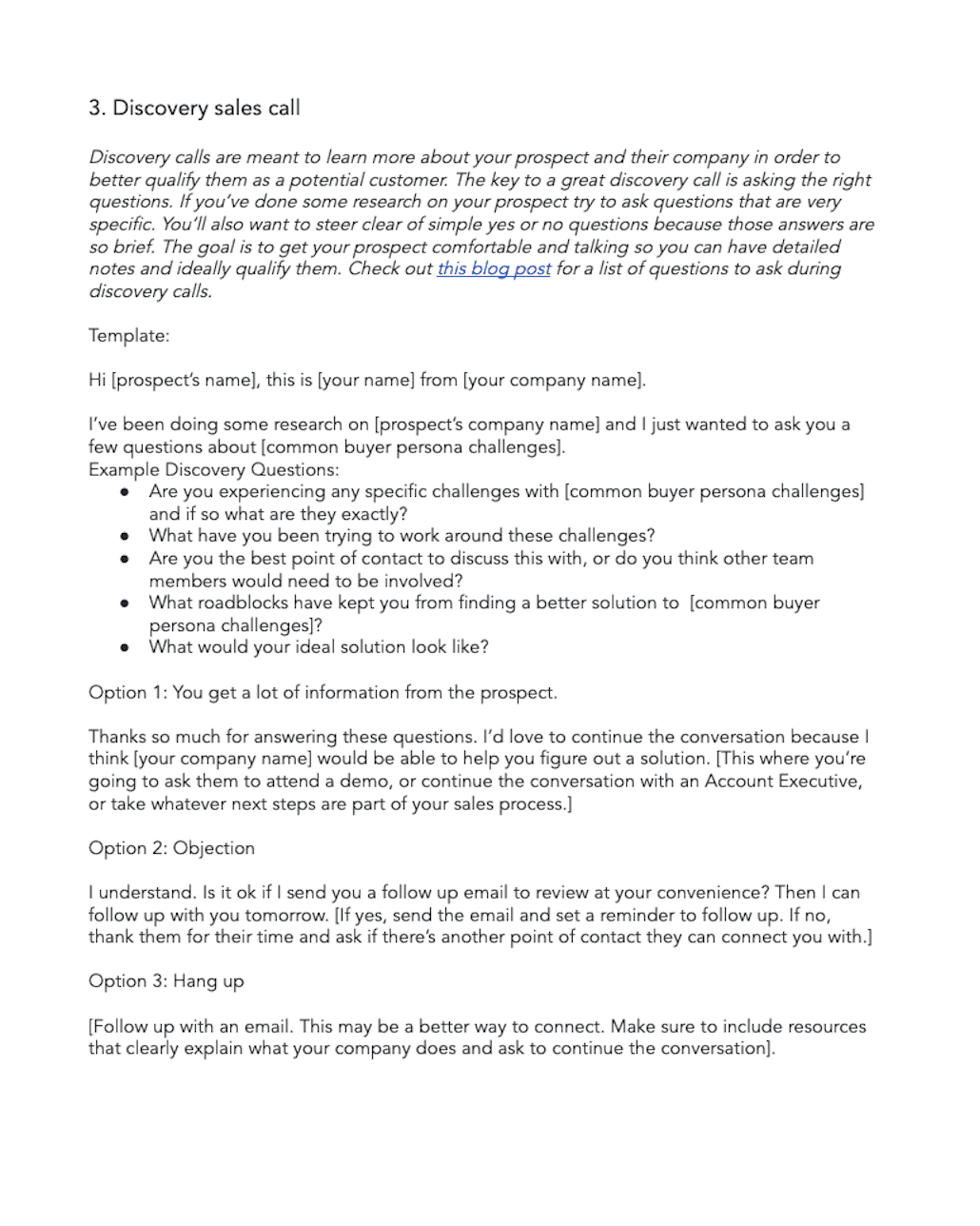How to Build a Winning Sales Pitch Script (+ Examples)
- February 4, 2022


With competition heating up in nearly every industry, standing out and nailing your pitch is the difference between closing a deal and taking a loss.
Going into a pitch unprepared, fumbling over your words, and talking in circles shows a lack of consideration and professionalism – not exactly the first impression you want to make with a prospect.
But with the right methodology and approach, you can set your sales reps up for having successful and meaningful conversations that turn prospects into leads. If you’re looking to level up your calls, it’s smart to consider creating sales pitch scripts.
Types of Sales Pitch Scripts
- In-person
- Sales call
- Voicemail
- Beating the competition
- Product demo
What is a Sales Pitch Script?
A sales pitch is a discussion between sales reps and a prospective customer about a product or service. It’s ideally a well-structured and clearly directed conversation that’s designed to bring both parties into a mutually beneficial opportunity.
A sales script is process documentation that takes the form of a standard operating procedure (SOP) or guide that salespeople use when talking to a lead and delivering their pitch.
Sales scripts are designed to help navigate the stages of a standard sales pitch and provide guidance as sellers strategically steer the conversation. Having a reference for guiding these conversations reduces stress and supports sellers in conducting a productive conversation.
A sales pitch script can be as detailed as a word-for-word conversation, or as broad as a list of key talking points. No matter your pitch style or approach, sales scripts are useful sales prospecting tools. A company that isn’t using scripts at all is likely missing out on potential revenue.
Types of Sales Scripts
A sales pitch can take many forms– sometimes you’re in-person and need to prepare for a room with an audience, sometimes you’re meeting over Zoom and need to prepare for the unique nuances of video calls. Maybe you’re cold calling for the first time and your prospect is hard to reach, so you need to leave a voicemail or send a follow-up email. Outreach is unique to every company.
Because each pitch is a unique case, it will also require a unique approach – it’s important to be prepared for anything.
Here are some of the types of scripts that could be beneficial to your sales team:
- In-person
- Sales call
- Voicemail
- Beating the competition
- Product demo
Depending on your company culture and industry, you may decide to implement several types of sales pitch scripts. Determine which scripts work best for your sales strategy so your sales reps feel prepared and empowered to close the deal– or, at minimum, secure positive next steps.
Benefits of Using Sales Pitch Scripts
Here are the benefits that creating and using sales cold pitch scripts have on sales organizations:
1. More prepared sales team
Without a solid concept of the important talking points or an ideal trajectory of where the conversation should go, your sales team can end up looking sloppy, unprepared, or unreliable. Having at least the bones of a script to help shape the course of the conversation can be extremely valuable when engaging with prospects.
2. Boost sales efficiency & productivity
Using a sales pitch script can help minimize the frequency of low-performance days by giving your sales reps an easy guide to follow. While most experienced sellers will tweak or improvise some of the script, they will always have a safety net to fall back on if they’re ever not feeling as creative or they need to redirect the conversation.
3. More effective sales rep training
With a documented sales pitch script in place, you can train new hires faster and more effectively. They’ll have something they can easily reference during their training period, which will speed up their ramping time. You can be confident that they won’t trip over their words on their first client call, which will build their confidence and help them make a good connection with prospects faster.
4. Better communication with prospects
Having a sales pitch script enables your team to listen better by decreasing stress or having to think on their feet. When they’re so concentrated on what they’re saying, it becomes very difficult to listen effectively. With a written script, sellers have their thoughts and words clearly in mind and you can be confident that your messaging is consistent.
Sales scripts can get a bad reputation. The fact is, a strong sales script can be a game-changer for your company and your sales team.

How to Write a Script for Your Sales’ Pitches
Writing a sales pitch script prepares sales reps for any pitch, providing a balance of structure and flexibility that allows room for adjustments based on each prospect and conversation.
It should include all the information and material your sales team will need to be successful, like product or service details, company background, and success stories.
The key to writing a strong sales pitch script is to lead the conversation with intention. It’s all about showing prospects that you have your act together, your product is worthwhile, and you can confidently navigate them through their customer journey.
Here are the essential elements of a solid sales pitch script:
1. Opening
The opener is an opportunity to greet your prospect and make a good impression right from the jump. This typically involves sharing your name and company name, exchanging niceties, thanking them for agreeing to speak with you, and kicking off the conversation with a question that encourages small talk.
2. Agenda
The agenda should outline the flow of the conversation. You’ll always want to start with the reason for your outreach, often phrased in a way that presents your service or product as a solution to their problem or pain point. Your agenda should always include a designated time for questions so your prospect knows you’re attentive to their needs and concerns.
3. Problem or opportunity
Identifying the problem or opportunity for your prospect is the true beginning of your actual sales pitch. During this portion, you’ll want to reiterate the main issue or problem, and then identify the underlying causes that you discovered during your research. Making a personalized observation or recommendation will paint you as an expert they’ll want on their side.
4. Proposed solution
The proposed solution portion of your script explains the product or service you’re offering – one that you believe will solve the prospect’s problem and help them reach their goals. This section also educates your prospect on how your solution works, or at minimum the basics. Sometimes sellers will use a product demo to give a visual representation and make it easier to understand a product’s function and application.
5. Benefits & value
This section is where you make your prospect see the value of your solution. To do this, share some key benefits of your product or service and the positive impact it has had on current clients. Share your unique selling points and what makes you different, explaining why your product or service is the best choice for them compared to other similar options.
6. Recap & CTA
To close out the conversation, recap the most influential talking points and encourage the prospect to take some sort of action. You can simply summarize your sales pitch – problem, solution, benefits – and discuss typical next steps, whether that’s to sign the contract or to schedule another meeting. Your company’s unique sales process will determine your optimal next steps.
7 Tips for Writing an Effective Cold Sales Pitch Script
To close out the conversation, recap the most influential talking points and encourage the prospect to take some sort of action. You can simply summarize your sales pitch – problem, solution, benefits – and discuss typical next steps, whether that’s to sign the contract or to schedule another meeting. Your company’s unique sales process will determine your optimal next steps.
1. Be focused, compelling, and concise
A good sales pitch should convey the intended message in a concise and compelling manner. If your pitch is on point and to the point, you’re on the right track to making a meaningful client connection.
The first few minutes of a sales pitch will determine the direction of the interactions to follow. Be sure to hit all your discussion points and flow through the conversation tactfully. Remember – this is your opportunity to convince the prospect about the superiority of your service or product.
2. Establish rapport
Establishing a friendly, sympathetic, and cooperative relationship between you and your prospect is one of the most impactful ways to nail your sales script.
Knowing they can trust you or simply that they like you is the difference between landing a sale and being written off. Find a way to connect with each prospect and what makes them unique. It also never hurts to try for a laugh – people remember conversations that left them in good spirits!
3. Prepare for objections
No matter how solid your sales pitch is, there will always be people who are iffy to take the plunge– it’s simply the reality of sales.
Preparing yourself for common objections or concerns will help you navigate those difficult conversations.
Here are some common pushbacks that you might encounter and should have a response for:
- They’re happy with a competitor.
- Your product/service is out of their budget.
- They’re not authorized to sign off on it.
- They don’t see the benefit of your product/service.
- They’re busy at the moment.
- They don’t want to get stuck in a contract.
- They’re simply not interested.
If you can prepare for these objections, you won’t feel caught off guard and you can provide a more direct solution.
4. Hone in on target audience
If you’re not targeting the right audience, your pitch won’t go well – no matter how much or how well you prepare.
Take the time to really get to know your targeted audience – figure out what their pain points are or what makes them unique, and learn to see the issue from their perspective. Spending time and resources going after prospects whose needs don’t align with your product and services won’t get you very far – instead, determine who would truly benefit from your offerings and make sure to tailor your pitch accordingly.
5. Identify the right solution
If you happen to offer a variety of products or services, do your research to determine which of your solutions is most applicable to each prospect you pitch to.
By showing prospects that you took the time to identify a specific product that’s aimed at resolving their particular roadblocks, you’re demonstrating your dedication to providing a tailored solution. Pushing all your services – unless there is a genuine benefit to the prospect – or not providing specific enough recommendations can make you seem artificial and detached.
6. Prepare for common questions
Even if you cover all your bases thoroughly during your pitch, questions are inevitable, and they’re actually a great thing – questions typically mean your prospect is engaged.
Prepare for a smooth dialogue by jotting down the most common questions your sales reps hear during pitches and crafting a response. Being able to answer those FAQs will further demonstrate your expertise in the field.
7. Use data
In sales, you deal with a lot of numbers. The main reason: it’s hard to argue with them.
Presenting data is an efficient way of letting the value of your product speak for itself. Come prepared with data that illustrates that impact – recent case studies, client wins, and monthly or quarterly reports are all great ways to demonstrate your value using data.
However, be sure not to data dump on your prospect – just bring the data that tells the best story about your solution.
Things to Avoid In Your Sales Pitch Script
The way you approach your sales pitch can make the difference between landing a sale or dealing with rejection.
Knowing what not to do during a sales pitch is equally as important as knowing best practices and tips for closing – it’s all about the impression you make. Small, subtle things can significantly sway the outcome of your pitch.
Here are some things to avoid in your sales pitch script for a more constructive conversation:
1. Using “You” as much as possible
Frequently using “you” in a sales pitch can come off somewhat aggressive. It can make prospects feel uncomfortable or like they’re in the hot seat, when the goal of your conversation should be to put them at ease.
Instead, focus on your company and the solution or services you provide. Saying “Our product can solve X issue” or “Our services can remedy X pain point“ instead of “Your processes aren’t efficient” or “Your services could use improvement” will have a much greater impact and build trust.
2. Sounding robotic
As common as sales pitch scripts are, you don’t want prospects to be able to tell you’re using a script.
Sounding like you’re reading from a script makes for awkward, stale, inauthentic conversation. To avoid sounding robotic, commit to practicing your pitch and running through the essential elements of the script so you sound more natural – you’ll be amazed at the difference it makes.
3. Thinking like a seller
The quickest way to lose a lead is by going into a pitch thinking only like a seller.
Showing empathy for your prospect’s perspective is an impactful way of gaining trust and building rapport. If prospects think you’re only viewing the partnership from a seller’s perspective, they’re less include to trust you and are going to be resistant, most likely feeling like you don’t have their best interest in mind.
4. Doing all the talking
As tempting as it is to control the conversation, doing all the talking during a pitch can actually do more harm than good.
No one likes being talked at, and it definitely doesn’t make for a good first impression. You’ll lose prospects’ attention if you ramble at them – instead, you want to aim for an open, balanced dialogue. Be sure to pause for feedback and make time for questions.
5. Sticking exactly to the script
Though the script is there to provide guidance and structure, you don’t always need to follow it exactly to a T.
Don’t think of your sales pitch script as a rigid, repeatable, word-for-word checklist with no room for deviation — think of it more as a guide. Any successful sales conversation will have some degree of improvisation and finesse, if and when appropriate.
3 Examples of the Best Sales Call Script Templates
If you’re looking for inspiration to craft your sales pitch script, we’ve compiled 3 of the best sales pitch script templates for you to explore:
1. Selling Signals
Selling Signals has a generic sales call script that you can customize to fit your specific needs. It includes the verbiage and crucial elements featured in some of the most effective sales call scripts, including a personable and professional opening, a problem-oriented sales pitch, and a strong call-to-action (CTA) that should close the deal.
2. Hubspot
Hubspot offers several unique sales pitch script templates that provide useful guidance based on the type of outreach – discovery sales call, in-person product demo, etc. Each template covers various scenarios like handling objections, information overload, and being hung up on, so there’s nothing your sales team won’t be prepared for.
3. Sales Scripter
Sales Scripter takes a unique approach to creating personalized sales pitch script templates. Simply enter your information into the software, and it will “interview” you to gather the key elements that should shape your sales scripts. The software will then use the information you provided to fill in the details. You can make the scripts your own by easily modifying the software-generated templates based on your company goals or industry.
Having a baseline sales script to help shape the course of a product pitch conversation can be extremely valuable when engaging with prospects.
A sales call script gives your sales reps the right words, talking points, and conversational flow to efficiently move prospects toward the finish line — a closed deal. Regardless, the script should be relatively structured and include areas that are easy to fill in so your sellers can personalize it as necessary.
When you provide your sales team with a sales pitch script that is well-developed, they’ll have the right guidance to go from one stage of the sales funnel to the next in a proven model that actually produces positive outcomes.
But remember: creating a successful sales script is an ongoing process. By regularly revisiting and updating your script, you’ll continue to find new, impactful ways to close more deals. Even if you only do it once a quarter or even just once a year, that alone can make a huge difference to your bottom line.
With Whatfix, you can empower your sales team to sell better. Using guided walkthroughs and embedded self-help widgets, you can support your sales teams with performing routine and advanced CRM processes, and much more. Explore Whatfix’s digital adoption platform today.
Request a demo to see how Whatfix empowers organizations to improve end-user adoption and provide on-demand customer support





